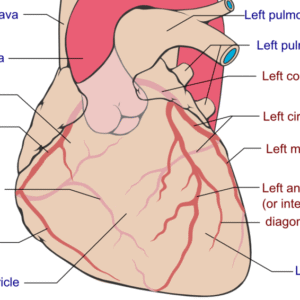Cardiology > Antiarrhythmic Drugs
Antiarrhythmic Drugs
Background
Antiarrhythmic drugs are pharmacological agents that modify the electrical activity of the heart to suppress or prevent abnormal rhythms (arrhythmias). They act on ion channels, autonomic tone, or nodal tissue to restore and maintain sinus rhythm, control ventricular rate, or terminate arrhythmic episodes.
They are used to manage supraventricular and ventricular arrhythmias, improve symptoms, prevent recurrence, and reduce the risk of arrhythmia-related complications such as stroke or sudden cardiac death.
Classification/Types (Vaughan–Williams System)
Class I – Sodium Channel Blockers
IA: Quinidine, procainamide, disopyramide
Moderate Na⁺ block, prolong repolarization (↑QT).
IB: Lidocaine, mexiletine
Mild Na⁺ block, shorten repolarization (↓QT).
IC: Flecainide, propafenone
Strong Na⁺ block, minimal effect on repolarization.
Class II – Beta-Adrenergic Blockers
Examples: Metoprolol, propranolol, esmolol, carvedilol.
Reduce sympathetic stimulation, slow AV conduction, and decrease automaticity.
Class III – Potassium Channel Blockers
Examples: Amiodarone, sotalol, dofetilide, ibutilide.
Prolong repolarization and refractory period (↑QT).
Class IV – Calcium Channel Blockers (non-dihydropyridine)
Examples: Verapamil, diltiazem.
Slow conduction through AV node, reduce automaticity.
Other Important Agents
Adenosine: AV nodal blocker for paroxysmal supraventricular tachycardia (PSVT).
Digoxin: Enhances vagal tone, slows AV conduction (mainly in atrial fibrillation with heart failure).
Ivabradine: Inhibits funny current (If), reducing sinus node rate.
Clinical Rationale
Arrhythmias arise from abnormal impulse formation (enhanced automaticity, triggered activity) or abnormal impulse conduction (reentry circuits, conduction block). Antiarrhythmics act by modifying ion channel activity or autonomic inputs, altering conduction velocity, refractoriness, or pacemaker activity to suppress arrhythmias.
Indications
Atrial fibrillation/flutter: Rhythm control (amiodarone, sotalol, flecainide) or rate control (beta-blockers, diltiazem, digoxin).
Supraventricular tachycardia (SVT): Adenosine, verapamil, beta-blockers, Class IC drugs in select patients.
Ventricular arrhythmias: Amiodarone, lidocaine, mexiletine, sotalol.
Prevention of sudden cardiac death in select high-risk patients (ICD generally preferred, but amiodarone may be used).
Wolff-Parkinson-White syndrome: Procainamide, flecainide; avoid AV nodal blockers.
Contraindications
Class IC: Avoid in structural heart disease (post-MI, cardiomyopathy) due to proarrhythmia risk.
Beta-blockers/CCBs: Contraindicated in severe bradycardia, AV block, or acute decompensated heart failure.
Amiodarone: Contraindicated in iodine allergy, severe thyroid or pulmonary disease.
Sotalol/dofetilide: Avoid in prolonged QT or severe renal dysfunction.
Physical Exam Findings Correlated
Vital Signs
Tachycardia (SVT, AF with RVR, VT).
Bradycardia or hypotension as side effects.
General Appearance
Palpitations, dizziness, syncope, or fatigue associated with arrhythmias.
Cardiovascular System
Irregularly irregular pulse in atrial fibrillation.
Sustained rapid or wide-complex tachycardia in ventricular arrhythmias.
Neurological System
Syncope, confusion, or seizure-like activity during arrhythmic episodes.
Advantages
Effective acute and chronic control of arrhythmias.
Symptom relief and improved quality of life.
Some agents (e.g., amiodarone) effective in both supraventricular and ventricular arrhythmias.
Limitations
Proarrhythmia risk (torsades de pointes, VT).
Narrow therapeutic windows.
Frequent need for monitoring (e.g., amiodarone toxicity surveillance, INR with warfarin if combined).
Limited mortality benefit compared with device therapy (ICDs).
Complications and Adverse Effects
Class IA: QT prolongation, torsades de pointes, lupus-like syndrome (procainamide).
Class IB: CNS toxicity (confusion, seizures).
Class IC: Proarrhythmia in structural heart disease, blurred vision, dizziness.
Beta-blockers: Bradycardia, bronchospasm, fatigue.
Amiodarone: Pulmonary fibrosis, thyroid dysfunction, hepatotoxicity, corneal deposits, skin discoloration.
Sotalol/dofetilide: QT prolongation, torsades de pointes.
CCBs (verapamil, diltiazem): Bradycardia, hypotension, constipation.
Adenosine: Transient flushing, chest discomfort, bronchospasm.
Digoxin: Narrow therapeutic index; toxicity includes GI upset, visual disturbances (yellow vision), arrhythmias.
Follow-Up and Clinical Decision-Making
Baseline and periodic ECG: To monitor QT interval, QRS width, and bradyarrhythmia risk.
Organ function monitoring: Thyroid, liver, lung (for amiodarone), renal function (for sotalol/dofetilide).
Therapeutic drug levels: Digoxin.
Adjunct therapy: Anticoagulation in atrial fibrillation for stroke prevention.
Escalation: Consider catheter ablation or device implantation if drug therapy fails or is contraindicated.
Stay on top of medicine. Get connected. Crush the boards.
HMD is a beacon of medical education, committed to forging a global network of physicians, medical students, and allied healthcare professionals.

